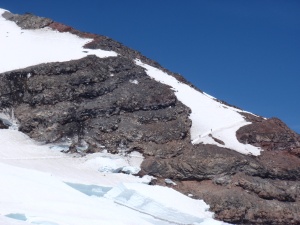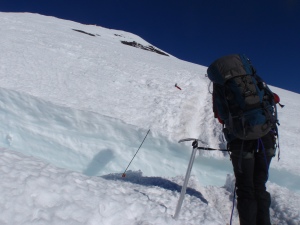I sure hope it will not be the last! After the annual American Association of Physicists in Medicine conference, two lost jackets, a cancelled hotel room, one missed talk, a ride to nowhere and a flooded bathroom later, the three of us took off for Mount Rainier (14,411 ft/4027 m):
Magdalena, Czech, adventurous athlete, McGill graduate, research instructor in medical physics at Stanford and the biggest glissade fan I have ever met. She is to be credited for the trip idea and securing climbing permits.
Matt, Stanford Applied Physics alumni, QA engineer at Accuray, calm and unflappable, excellent rope team leader, sustains his climbing stamina with chocolate-covered espresso beans. Being male & American made him the minority representative in our team.
Sonja, also a medical physicist at Stanford, happy middle member and tortoise of the rope team (makes everybody else feel really strong!), always ready with a precocious comment.
We got our climbing permits and blue bags at Paradise Valley at 1 pm on Friday and took off at 1:30 pm. Due to the high snowfall and cold spring, mushy snow was with us from the beginning. Matt was almost bowled over by a glissading tourist, who he elegantly deflected to a different direction with a firm shove. The thick cloud cover started just above the trailhead. Soon, we were in the clouds with very limited visibility, but limited tourist exposure as well. Our hair and clothing gathered so much moisture that I pondered the possibility of moss or algae starting to grow on us if we took a rest break. We took our late lunch at Pebble Creek, having reached the upper level of the clouds. There was, indeed, a mountain above the clouds, and what an impressive one! I had seen glaciers in the alps, but nothing compared to the masses of ice and snow looming above us.
Lack of sleep from the conference and the missing first night at 6000 feet caught up with me, so I let Matt and Magdalena forge on ahead to work my way up the Muir Snowfield slowly at my own pace. Soon, the fast climbers were ahead, the day-hikers had turned around, leaving me by myself in the stillness of the cool mountain air. To the left of me, the Nisqually icefall entertained me with almost constant rock and ice falls, kicking up sprays of ice and dust clouds. The debris from the huge ice fall in June was clearly visible.
At 7:30 pm, I too arrived at Muir Camp, last climber of the day. My companions had generously prepared a bivy platform for me already. I quickly rolled out my bivy, put on all my clothes to ward of the chilly 20 F/-7C night air, crawled in my sleeping bag and barely finished a hot cup of tea before falling fast asleep. So far, I have not encountered any of the typical sleeping problems at altitude; on the contrary, my body seems to demand lots of sleep to adapt.
Saturday was planned as an acclimatization day. I woke up at 8 am, had breakfast, took another nap. Around noon, I joined the others on their perch halfway up Muir Rock to take my afternoon nap. In the late afternoon, we prepared our gear for the next morning, had an early dinner to be ready for bed as soon as the sun disappeared behind Gibraltar Rock at 6 pm. We had planned for getting up at 30 minutes past midnight, but our neighbors we so loud getting ready for their climb that we just got up and going as well. There were two large guided groups and a few other private rope teams on the traverse across Cowlitz glacier when we started. After we had passed beyond the bottom of Cathedral Rocks to arrive at the switchbacks to Cathedral gap, we stopped with another rope team to shorten the ropes for the ascent. Quite suddenly, a good-sized rockfall came down from Cathedral. In the dark night we could not see what was going on, but there were at least a half dozen small rocks plus one boulder on their way down from the sound of it. Yells of “rock” echoed over the Cowlitz glacier. With all the rope teams on the move, it was incredible luck that thee team behind us had just pulled close enough and the next team was just enough behind to be out of harms way.
The following ascent to Cathedral Gap was uneventful. We lengthened the ropes again for the traverse across Ingraham Glacier. The large private group “Team Tortoise” behind us, we, the newly christened “Physics on the Rocks”, forged ahead. Soon we reached a short bridge over a bottomless crevasse. What fun! The headlamps of the roped teams on Disappointment Cleaver (DC) outlined the mountain above us. High up, we could not tell where the strings of headlamps ended and the starry skies started. Several times, Matt spotted shooting stars.
Just at the base of the DC, we encountered a situation we we unprepared for. A small rockfall started from the DC coming down a narrow chute just above me. Instinctively, Matt in front and Magdalena in the back moved away from the rock fall, which left me stuck right in the middle on a taut rope, unable to dodge any rocks. Again, Lady Luck was gracious and I just got pelted with a few pebbles which had not gathered a lot of speed yet. We have our homework cut out for us: research what the appropriate response would have been.
The ascent of the DC was uneventful. No fixed lines, but a well-worn path on hardened snow with good bite for our crampons. The slope looked steep at night. Dawn started to light up the horizon. We rested for 5 minutes atop the DC to pull on layers, drink, and get ready for the next traverse onto the ridge. A couple hours of hard, consistent work got us high up on the mountain. The sun came up deep red over the Cascades behind us. Just above 13,000 ft/4000 m, the three of us almost simultaneously fell into rest step. Beyond the end of the ridge, another traverse and the second fun, exciting crevasse. While the trail had woven mostly between crevasses, with the exception of the first bridge, this crevasse at 13,800 ft/4200m had to be jumped, uphill no less! With Magdalena and myself anchored securely, Matt took a leap, landing a safe step beyond the rim, quickly stepping up to the anchor and sling a climbing ranger had set above. Now it was my turn. My somewhat shorter legs and lack of energy required me to use the anchored rope for gaining the extra momentum needed to clear this obstacle. Magdalena, of course, did fine.
Only 600 feet/200 m left! This was the point at which I had hit the wall on Shasta two weeks before, but today I felt strong. The rocks of the crater rim in sight and the summit almost ensured, a boost of excitement gave me the kick and up we went. What a joy to stand on the rim!!! We dropped down into the crater where we left our rope and ice axes. Matt spotted the steam vents. Magdalena took a rest, while I forged ahead for the last 200 feet up to Columbia Crest. It was good to have some alone time; the summit tears for my mom flowed quite freely. That 4th climbing pass would for sure not have gone unused if she was still around!
All smiles and excitement on Columbia Crest! About a dozen very happy mountaineers cheering, snapping pictures, enjoying their achievement.
We did not stay long, because we wanted to get as far down as possible before the snow softened too much in the hot sun. Magdalena’s stomach gave its usual opinion about the altitude as well. Jumping down the crevasse was much easier, although I did stumble a bit on landing. Philip the ranger met us for the second time. Yes, he did two ascents of Rainier that morning, heading down another way. The first ascent from Camp Muir to summit and back took him 4 1/2 hours, solo. We mere mortals proceeded downhill at about 1000 feet/hour, shedding layers along the way, until we reached the top of the DC. It was here we the hardest part of our climb started. The snow was mushy, the sun was hot, the slope steep, the rope team above us freely gave their opinion on the descent quality which we were only thinking loudly, and are definitely not fit for print.
At the base of the DC came the long traverse below the Ingraham ice fall. Ranger Philip had to mention the evening before that statistically, this are is the most dangerous section of the whole mountain, where once a rope team of 10 had been lost in an instance. Yikes. I think this was the first time ever Matt had me fuss at him to hike faster! Neither of us liked this section; we were sure glad we had not been able to see those seracs on our ascent at night! The rest of the descent was uneventful. Around 12:30 pm, we were back in Camp Muir with a sunny afternoon to relax, enjoy the views and bask in our achievement. Our knees were quite thankful that they did not have to continue on to Paradise Valley. That was left for the next morning.
The descent was fun, plenty of safe glissade chutes provided us with a speedy way down. The Nisqually let loose with another serac fall. Without the clouds, we got a good look at the Fuehrer route, which a few people were taking. High up on my list for next time 🙂 Surprisingly, there are no showers within 25 miles of the park entrance. Now here is a business opportunity. Dirty as we were, we stopped by at Whittaker Mountaineering anyway. Later on, we found a campground with showers to make ourself presentable enough to not annoy our seat neighbors on the plane. A pizza, lost jacket retrieval, and Latte later, we were at Seattle-Tacoma airport. I used the wait time to read John Muir’s essay on his Rainier climb, dreaming off more volcano climbs to come.






What a fabulous climb! I’m so proud of you!
Pingback: My year of climbing volcanoes: Grand Finale in Ecuador | Stories from inside the shell